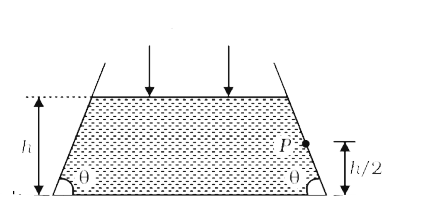The density of a metal at normal pressure is ρ. Its density when it is subjected to an excess pressure p is ρ' . If B is the bluk modulus of the metal, then find the ratio ρ'/ρ.
11−pB
1+BP
11−BP
1+pB
The correct Answer is:A
To find the ratio of the densities ρ′ρ of a metal under normal pressure and under excess pressure p, we can follow these steps:
Step 1: Understand the relationship between density and volume
Density ρ is defined as mass per unit volume:
ρ=mV
where m is the mass and V is the volume.
Step 2: Establish the relationship between densities
When the metal is subjected to an excess pressure p, its density changes to ρ′. The mass m remains constant, so we can express the new density as:
ρ′=mV′
where V′ is the new volume after applying the pressure.
Step 3: Relate the volumes
Since the mass is constant, we can write:
ρ′ρ=VV′
Step 4: Use the definition of bulk modulus
The bulk modulus B is defined as:
B=−pdVV
where dV is the change in volume. Rearranging gives:
dVV=−pB
This means that the new volume V′ can be expressed as:
V′=V(1−pB)
Step 5: Substitute the new volume into the density ratio
Substituting V′ into the density ratio gives:
ρ′ρ=VV(1−pB)=11−pB
Step 6: Final expression for the density ratio
Thus, the ratio of the densities can be expressed as:
ρ′ρ=11−pB
Conclusion
The final result for the ratio of densities under normal and excess pressure is:
ρ′ρ=11−pB
---
Density ρ is defined as mass per unit volume:
ρ=mV
where m is the mass and V is the volume.
When the metal is subjected to an excess pressure p, its density changes to ρ′. The mass m remains constant, so we can express the new density as:
ρ′=mV′
where V′ is the new volume after applying the pressure.
Since the mass is constant, we can write:
ρ′ρ=VV′
The bulk modulus B is defined as:
B=−pdVV
where dV is the change in volume. Rearranging gives:
dVV=−pB
This means that the new volume V′ can be expressed as:
V′=V(1−pB)
Substituting V′ into the density ratio gives:
ρ′ρ=VV(1−pB)=11−pB
Thus, the ratio of the densities can be expressed as:
ρ′ρ=11−pB
The final result for the ratio of densities under normal and excess pressure is:
ρ′ρ=11−pB
Topper's Solved these Questions
- ELASTICITYBook:DC PANDEY ENGLISHChapter:ELASTICITYExercise:Match the columns
Explore 4 Videos
- ELASTICITYBook:DC PANDEY ENGLISHChapter:ELASTICITYExercise:Medical entrances s gallery
Explore 21 Videos
- ELASTICITYBook:DC PANDEY ENGLISHChapter:ELASTICITYExercise:Check point 12.3
Explore 15 Videos
- CURRENT ELECTRICITYBook:DC PANDEY ENGLISHChapter:CURRENT ELECTRICITYExercise:All Questions
Explore 469 Videos
- ELECTROSTATICSBook:DC PANDEY ENGLISHChapter:ELECTROSTATICSExercise:Integer
Explore 17 Videos
Similar Questions
Knowledge Check
The pressure inside a liquid of density ρ at a depth h is :
AhρgBhρgChρgDhρThe pressure at depth h below the surface of a liquid of density ρ open to the atmosphere is
Agreater than the atmospheric pressure by ρghBless than the atmospheric pressure by ρghCequal to the atmospheric pressureDincreases exponentially with depthThe density of water at the surface of ocean is ρ . If the bulk modulus of water is B, then the density of ocean water at depth, when the pressure at a depth is αp0 and p0 is the atmospheric pressure is
AρKk−nP0BρKK+nP0CρKK−(n−1)P0DρK(K+(n−1)P0)
The density of the given gas at constant pressure and temperature is ρ and its rate of diffusion isr. If density of the gas becone ρ/3 then rate of diffusion becomes
View SolutionThe pressure (p) and the dencity ρ of given mass of a gas expressed by Boyle's law, p=Kρ holds true.
View SolutionDuring adiabatic process pressure (p) versus density (ρ) equation is
View SolutionA ball of density ρ0 falls from rest from a point P onto the surface of a liquid of density ρ in the time T. It enters the liquid, stops, moves up, and returns to P in a total time 3 T. neglect viscosity, surface tension and splashing find the ratio of ρρ0
View SolutionA container (see figure) contains a liquid upto a height h. The density of the liquid is The gauge pressure at point P is ρghx. Find the value of x

View Solution

